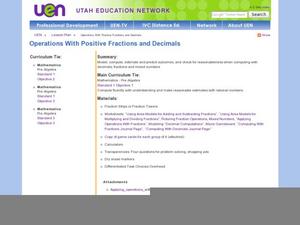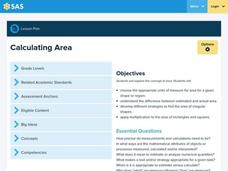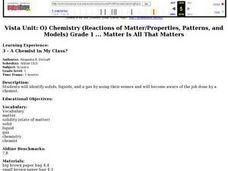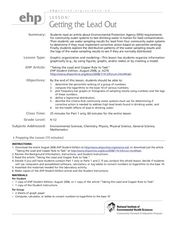Curated OER
An Electron's Address
Where does an electron reside? Chemistry scholars determine an electron's "address," that is, what orbital it can be found in. This resource is both instructional and practical, providing a thorough explanation of energy levels and...
Curated OER
Operations with Positive Fractions and Decimals
Explore the concept of fractions and decimals! In this fractions and decimals lesson, pupils use fraction tiles to express fractions. They play a fraction review basketball game where when a team gets a question correct they get to shoot...
EngageNY
Even and Odd Numbers
Even or not, here I come. Groups investigate the parity of products and sums of whole numbers in the 17th lesson in a series of 21. Using dots to represent numbers, they develop a pattern for the products of two even numbers; two odd...
Curated OER
Topology - The Mathematics of Distortion
In this topology worksheet, 7th graders solve and complete 12 different problems that include shapes and math distortion. First, they use the forms of capital letters as guides, stretch or bend the shape in the first column into as many...
Curated Video
Reporting - Safety and Abuse Tool
Keep your charges safe online with instruction on how to report problems on YouTube. After providing learners with information on the Safety and Abuse Tool, demonstrate how to use the tool and discuss the feature. In groups, learners...
EngageNY
Differences Due to Random Assignment Alone
It takes a lot of planning to achieve a random result! Learners compare results of random assignment, and conclude that random assignment allows results to be attributed to chance. They also realize the set of random means...
EngageNY
Percent Rate of Change
If mathematicians know the secret to compound interest, why aren't more of them rich? Young mathematicians explore compound interest with exponential functions in the twenty-seventh installment of a 35-part module. They calculate future...
Math Worksheets 4 Kids
Solid Nets: With Tabs
Get in shape with a series of worksheets about making 3-D geometric shapes. Learners use the example at the top of the page to model their shapes, which range from a simple cube or cone to a more complicated octagonal pyramid.
Towson University
Mystery Disease
How did scientists determine the cause of illness before technology? Science scholars play the role of medical researcher in an engaging guided inquiry activity. Using observations, technical reading, and Punnett squares, learners...
Curated OER
The Ozone
Learners engage in instructional activity concerned with the concept of the ozone layer. They write a reflective journal using prior knowledge. Students read sources of information about the existence of a hole in the ozone layer....
Curated OER
What Color and Clothing Are You Wearing?
Young learners identify the type of clothing and color for eight multiple-choice questions. Just print this sheet out, and you're good to go!
Curated OER
Phonics: Decode and Write Words
Sounding out individual phonemes and blending them to make a word is usually one of the first tasks mastered when learning to read. Make master decoders out of your learners, they sound out a series of simple two and three-letter cvc...
Curated OER
Decomposing Numbers Step-By-Step
Here are two addition-related exercises. However, bear in mind, the explanations are featured below each of them. Use this as an all-class warm up, revealing the explanations if and when you see fit. First, examine the four sets of...
Curated OER
ESL Picture/Idiom Matching Worksheet
In this ESL picture to idiom matching worksheet, students examine 7 small clip art images before matching them to the idioms they best represent. They work with idioms such as "blood is thicker than water," and "as you make your bed, so...
Curated OER
Orbits Worksheet #2
Brief, but beneficial, this resource draws space scientists into the orbit of a moon around its planet. Assignees answer five multiple choice style questions using a diagram of the planet, the moon's orbit, its focal points, and the...
Curated OER
Wall Systems of Residential Structures
Students layout and frame-up a scaled-down model of a wall with one door and one window.
Curated OER
Shhh! Be Quiet
Teach the digraph sh with your learners. First, model the sound the digraph makes. Then, have learners spell a variety of words that use the target sound. Finally, read Shoe Man, where learners can hear the words in context.
Curated OER
What's Below the Earth's Surface?
Young scholars identify the geological layers of the Earth. They graphically depict each layer's characteristics. Students label and develop a color key for their exhibit. They create a down-to-Earth 3-D display with Erasable Markers.
Pennsylvania Department of Education
Multiplication Using Arrays
Explore the concept of multiplication by using arrays. Classmates use arrays to gain a better understanding of multiplication. They break arrays apart to model the distributive property of multiplication over addition. The relationship...
Curated OER
Sunrise-Sunset
Students gather data, make and share predictions about the time of sunrise ans sunset in their area. Patterns are analyzed and shared with students from other areas.
Curated OER
A Chemist in My Class?
First graders in kindergarten science class discuss matter. They make predictions and then identify mystery items in brown paper bags as either solid, liquid, or gas by using their senses. They discuss that a chemist is a scientist that...
Curated OER
Periodic Table of the Elements
First graders discuss, at their level, the concept of elements making up all matter. They discover the story of Dimitri Mendeleev and his discovery of the Periodic Table of the Elements. They locate and color some of the most common...
Curated OER
Music: Sounds on the Farm
Singing is a great way to build memory, music, and verbal communication skills. Little ones sing the song, "Old Mac Donald had a Farm." They make the sounds of each animal on the farm paying attention to signaling cues, singing high, and...
Curated OER
Getting the Lead Out
The article for this lesson no longer accessible through the links in the lesson plan, but can be found in the National Center for Biotechnology Information website. After reading it, environmental science students answer questions and...























